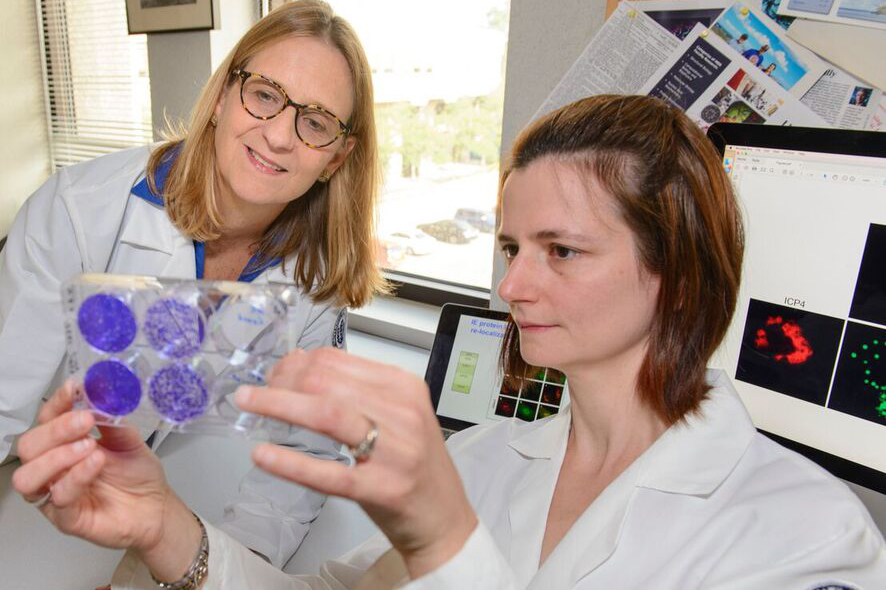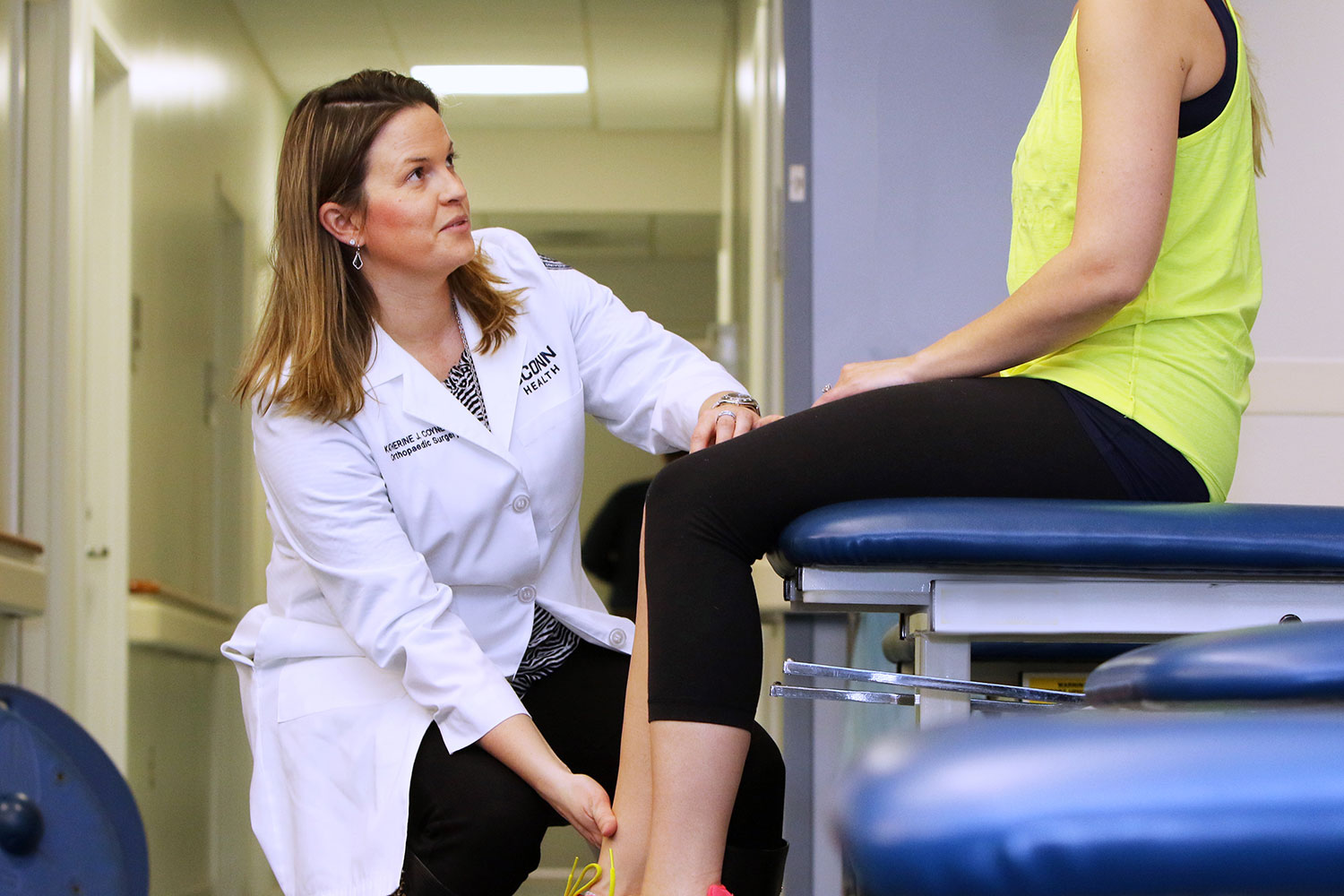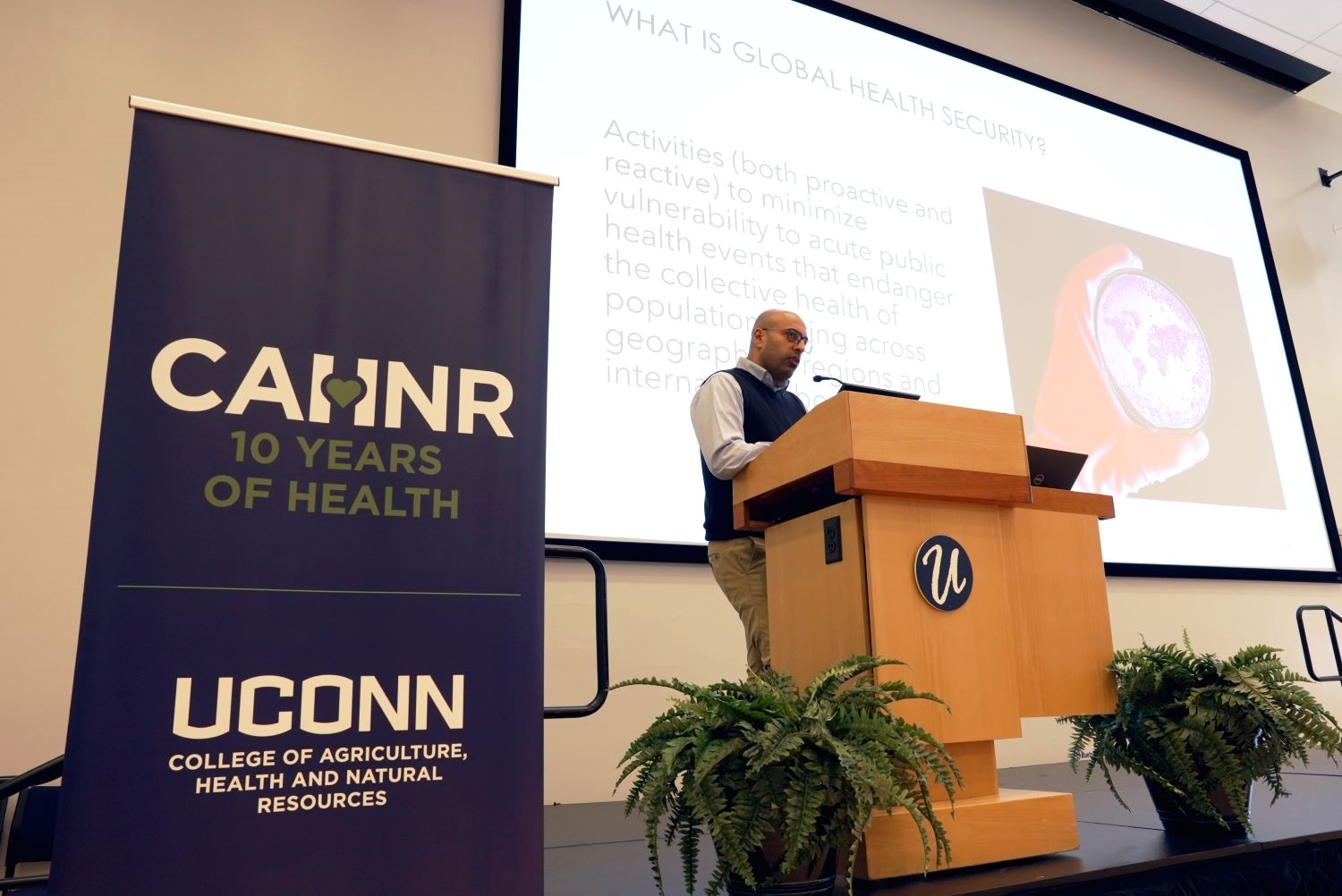Sandra Weller has devoted most of her career to learning how the ubiquitous herpes simplex virus replicates and infects people. She focused on this common pathogen because of its widespread impact – it infects two-thirds of the world’s population – and because of its painful symptoms, which can range in severity from bothersome to life-threatening.
But in the past year, she has shifted her focus to another member of the herpes virus family, cytomegalovirus, which has a much greater immediate patient need and stronger commercial potential. With support from a drug discovery consortium comprising UConn, UConn Health, and Yale University, Weller is now thinking like an entrepreneur to more quickly advance her scientific discoveries.
The consortium, known as Program in Innovative Therapeutics for Connecticut’s Health or PITCH, was established in 2016 to encourage commercialization of research from the state’s universities through the discovery of novel drug compounds. The initiative is supported by a three-year, $10 million investment managed by Connecticut Innovations.
“Programs like PITCH are critical to advancing academic discoveries that will help patients and grow Connecticut’s economy,” says Radenka Maric, vice president for research at UConn and UConn Health. “It also attests to UConn and Yale’s commitment to support cross-disciplinary collaborative research that addresses significant patient needs.
“Drug discovery is just one of the ways UConn is driving innovation in our state,” Maric adds, “innovation that will lead to new life-saving technologies, new companies, and new high-wage jobs.”
The threat of CMV
When Weller, Board of Trustees Distinguished Professor and chair of molecular biology and biophysics at UConn Health, presented her research to the PITCH advisory board, they were impressed with the scientific strategy and encouraged her to expand her project to an additional pathogen in the herpes family – cytomegalovirus (or CMV) – that has even more serious effects than herpes simplex and fewer treatment options.
Like herpes simplex, CMV is common and can infect people of any age. According to the Centers for Disease Control and Prevention, more than half of adults have been infected with CMV by age 40.
Cytomegalovirus usually remains dormant in infected people, and those infected show no signs or symptoms because their immune systems keep the virus in check. Problems arise when the immune system is suppressed and the virus is free to reactivate.
For patients receiving solid organ transplants, for example, CMV is particularly dangerous. It is standard for transplant patients to receive immunosuppressing drugs that allow the body to accept the new organ, but approximately 60 percent will have CMV infection and more than 20 percent will develop symptoms. Once CMV reactivates, transplant patients are more vulnerable to other infections, and it is more likely that the body will reject the new organ. Without effective antiviral drugs like the one Weller hopes to develop, CMV can also destroy organs and cause blindness.
Unlike herpes simplex, cytomegalovirus does not have an effective treatment option. While there are a few existing drugs that can mitigate active infections, they themselves pose a host of serious risks to patients. The first-line treatment, ganciclovir, has been shown to raise liver enzymes, negatively affect fertility, and cause cancer, among other adverse effects. Up to 10 percent of patients who receive ganciclovir for CMV stop treatment because of life-threatening kidney toxicity. Viral resistance to the drug also develops quickly.
Preventing dormant infections from reactivating
Weller and her team hit the ground running when they began their two-year PITCH project this past winter. Thanks to more than 30 years studying herpes simplex, Weller quickly found a homologue target protein that restricts CMV replication when inhibited.
“Think of the different pathogens within the virus family like different types of cars,” Weller explains. “All cars have the same core components, like an engine, seats, and wipers, but some might also have special features like all-wheel drive or a sunroof. Because our therapy is addressing the virus’s core components and not its special features, we expect it to be successful as a broad-spectrum therapy for the whole herpes virus family.”
Like other viruses, CMV has to package its genetic material so that it can infect human cells and proliferate. The protein Weller discovered is a crucial part of the cellular machinery that allows the virus to replicate its genetic material. If she can find a natural or synthetic compound that inhibits this protein, she can stop dormant CMV infections from reactivating.
Since she has identified a target protein, the next step requires synthesizing large quantities of the purified target for testing. Synthesis and initial characterization of the target protein took place at a research core facility in the Department of Molecular Biology and Biophysics at UConn Health.
This is where Yale’s expertise comes in. The Yale Center for Molecular Discovery has a vast library of small molecules that are used for high throughput screening. The PITCH staff are currently using this catalogue to evaluate whether Weller’s target protein responds to any of these natural or synthetic chemical compounds.
Once the Yale team identifies a compound that inhibits the target protein’s enzymatic activity, work will shift back to UConn at the School of Pharmacy, where medicinal chemistry professor Dennis Wright will optimize the compound. This entails striking the right balance between several qualities that make the future treatment the most beneficial for patients, such as efficacy and potency. The goal is to cure the disease with the smallest possible medicinal dose that can remain in the body long enough for once-daily treatments.
Weller and her team are not the only researchers trying to find a better treatment to tackle CMV. She welcomes the interest, and says it confirms the PITCH board’s suggestion to shift her research from herpes simplex towards another pathogen in the virus family.
“The fact that large and small pharmaceutical companies are working on this proves there is a definite need, and validates the market,” Weller says. “And in the case of viruses like CMV or HIV, you really need a cocktail of drugs. Resistance happens quickly, so the combination of treatments gives you a better chance of success.”
The Future of Drug Discovery
According to PITCH director, Janie Merkel, Weller’s project and programs like PITCH demonstrate the important role academic research plays in the pharmaceutical industry.
“The way we develop new drugs is undergoing a major transformation,” Merkel says. “Between the high cost of conducting internal research and development for pharma companies and federal dollars being harder and harder to come by for academic researchers, we see an increasing focus placed on commercial potential for academic science. Commercialization programs like PITCH are beneficial for academics and industry.”
Weller hopes more academic researchers will take advantage of programs like PITCH as an innovative way to support their scientific activities.
“Every scientist dreams of making a discovery in the lab that will positively impact people’s lives,” she says. “We want to find cures that help patients; and programs like PITCH teach us how to take the next step.”
Weller recently took the next step and formed a startup, Quercus Molecular Design (QMD), with colleague and fellow PITCH leader Dennis Wright. Through QMD, the two plan to take new antiviral therapies that they develop to human clinical trials, when the time comes. They are also committed to growing their company in Connecticut. The company’s name reflects this – “quercus” is the Latin word for “oak,” the state tree of Connecticut.
The next deadline to apply for PITCH is July 15, 2017. For more information, visit pitch.yale.edu.
June is CMV Awareness Month.



